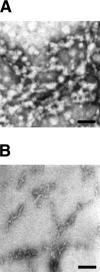The human serpin proteinase inhibitor-9 self-associates at physiological temperatures
- PMID: 15215529
- PMCID: PMC2279926
- DOI: 10.1110/ps.04715304
The human serpin proteinase inhibitor-9 self-associates at physiological temperatures
Abstract
The metastable serpin architecture is perturbed by extremes of temperature, pH, or changes in primary sequence resulting in the formation of inactive, polymeric conformations. Polymerization of a number of human serpins in vivo leads to diseases such as emphysema, thrombosis, and dementia, and in these cases mutations are present within the gene encoding the aggregating protein. Here we show that aggregation of the human serpin, proteinase inhibitor-9 (PI-9), occurs under physiological conditions, and forms aggregates that are morphologically distinct from previously characterized serpin polymers. Incubation of monomeric PI-9 at 37 degrees C leads to the rapid formation of aggregated PI-9. Using a variety of spectroscopic methods we analyzed the nature of the structures formed after incubation at 37 degrees C. Electron microscopy showed that PI-9 forms ordered circular and elongated-type aggregates, which also bind the fluorescent dye Thioflavin T. Our data show that in vitro wild-type PI-9 forms aggregates at physiological temperatures. The biological implications of PI-9 aggregates at physiological temperatures are discussed.
Figures





Similar articles
-
Serpin crystal structure and serpin polymer structure.Arch Biochem Biophys. 2006 Sep 1;453(1):123-9. doi: 10.1016/j.abb.2006.03.006. Epub 2006 Mar 23. Arch Biochem Biophys. 2006. PMID: 16631102 Review.
-
Identification and characterization of a misfolded monomeric serpin formed at physiological temperature.J Mol Biol. 2010 Oct 29;403(3):459-67. doi: 10.1016/j.jmb.2010.09.007. Epub 2010 Sep 17. J Mol Biol. 2010. PMID: 20837024
-
Molecular gymnastics: serpin structure, folding and misfolding.Curr Opin Struct Biol. 2006 Dec;16(6):761-8. doi: 10.1016/j.sbi.2006.10.005. Epub 2006 Oct 31. Curr Opin Struct Biol. 2006. PMID: 17079131 Review.
-
Osmolytes as modulators of conformational changes in serpins.Biol Chem. 2001 Nov;382(11):1593-9. doi: 10.1515/BC.2001.194. Biol Chem. 2001. PMID: 11767949
-
Refolding and polymerization pathways of neuroserpin.J Mol Biol. 2010 Nov 12;403(5):751-62. doi: 10.1016/j.jmb.2010.07.047. Epub 2010 Aug 4. J Mol Biol. 2010. PMID: 20691191
Cited by
-
AFM Imaging Reveals Topographic Diversity of Wild Type and Z Variant Polymers of Human α1-Proteinase Inhibitor.PLoS One. 2016 Mar 23;11(3):e0151902. doi: 10.1371/journal.pone.0151902. eCollection 2016. PLoS One. 2016. PMID: 27008547 Free PMC article.
References
-
- Bird, C.H., Sutton, V.R., Sun, J., Hirst, C.E., Novak, A., Kumar, S., Trapani, J.A., and Bird, P.I. 1998. Selective regulation of apoptosis: The cytotoxic lymphocyte serpin proteinase inhibitor 9 protects against granzyme B-mediated apoptosis without perturbing the Fas cell death pathway. Mol. Cell. Biol. 18 6387–6398. - PMC - PubMed
-
- Bladergroen, B.A., Strik, M.C., Bovenschen, N., van Berkum, O., Scheffer, G.L., Meijer, C.J., Hack, C.E., and Kummer, J.A. 2001. The granzyme B inhibitor, protease inhibitor 9, is mainly expressed by dendritic cells and at immune-privileged sites. J. Immunol. 166 3218–3225. - PubMed
-
- Bottomley, S.P. and Chang, W.-S. 1997. The effect of reactive centre loop length upon serpin polymerisation. Biochem. Biophys. Res. Comm. 241 264–269. - PubMed
-
- Bottomley, S.P., Hopkins, P.C., and Whisstock, J.C. 1998. α1-antitrypsin polymerisation can occur by both loop A and C sheet mechanisms. Biochem. Biophys. Res. Comm. 251 1–5. - PubMed
Publication types
MeSH terms
Substances
LinkOut - more resources
Full Text Sources
Research Materials
Miscellaneous

